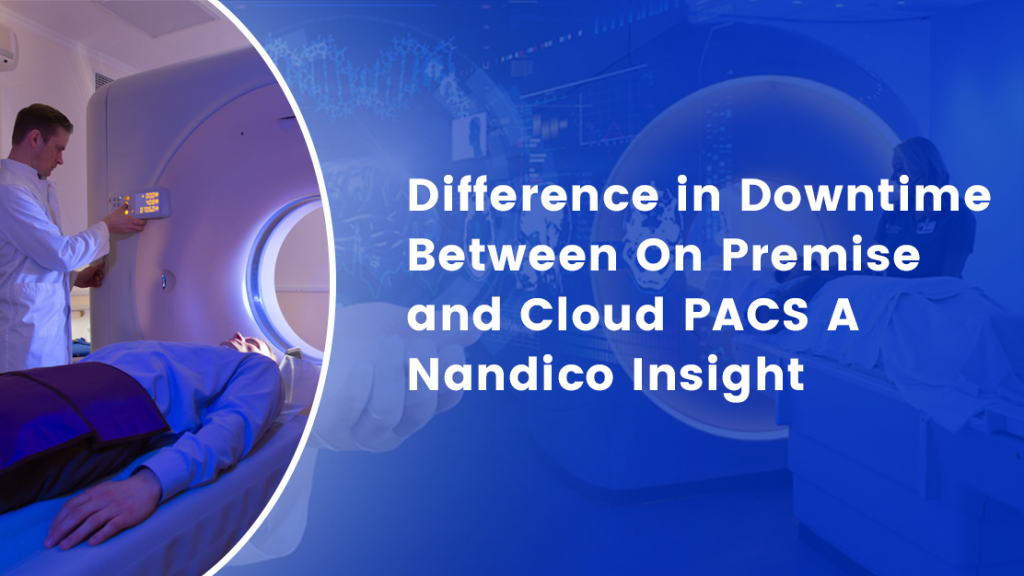
In radiology, downtime can be more than just an inconvenience—it can delay diagnoses, impact patient outcomes, and disrupt entire clinical workflows. One of the biggest considerations when comparing on-premise PACS and cloud-based PACS is the difference in downtime. At Nandico, we prioritize uninterrupted access to medical imaging, and we understand how critical system availability is to radiology operations.
Let’s break down the key differences in downtime between these two PACS models and how each affects radiology performance.
What is Downtime in PACS?
Downtime refers to the period when a PACS (Picture Archiving and Communication System) is inaccessible—either due to system failure, hardware issues, power outages, software upgrades, or network disruptions.
Downtime can be categorized as:
- Planned Downtime (for maintenance or updates)
- Unplanned Downtime (due to hardware failure, cyberattacks, etc.)
In both cases, the goal is to minimize downtime to maintain continuity of care.
Downtime in On-Premise PACS
On-premise PACS stores and manages all imaging data within the hospital or diagnostic center’s own physical infrastructure.
Common Causes of Downtime in On-Premise PACS:
- Hardware failures (server crashes, disk damage)
- Power outages or UPS failure
- Network misconfigurations
- Operating system or PACS software corruption
- Manual errors during updates or configuration
- Natural disasters (fire, flooding, etc.)
Average Downtime (Annually):
- Typically 40 to 100 hours per year
- Higher in small or resource-limited facilities
- Recovery may take several hours to days depending on backup systems
Risks and Impact:
- Imaging delays for patients and clinicians
- Manual processing or data retrieval
- Potential data loss if backups aren’t recent
- Costly emergency technical support
At Nandico, we often observe that on-premise PACS users lack real-time monitoring tools, increasing the MTTR (Mean Time to Repair).
Downtime in Cloud PACS
Cloud PACS is hosted on remote, redundant cloud servers managed by third-party providers with automated systems for uptime optimization.
Key Features Reducing Downtime:
- Auto-redundancy across multiple data centers
- Failover systems that instantly switch to backup nodes
- 24/7 monitoring by dedicated support teams
- Scheduled updates done without disrupting end users
- No dependency on local hardware
Average Downtime (Annually):
- Less than 12 hour per year (commonly measured as 99.99% uptime)
- Some providers offer 99.999% uptime SLAs, which equals just 5 minutes of downtime annually
Benefits of Cloud PACS Uptime:
- Instant recovery even in case of node failure
- No on-site intervention needed
- Radiologists can continue reporting remotely
- Scheduled maintenance occurs in the background
At Nandico, our Cloud PACS is backed by tier-4 cloud infrastructure, ensuring uptime consistency across all geographic locations.
Side-by-Side Downtime Comparison
| Feature | On-Premise PACS | Cloud PACS (Nandico) |
|---|---|---|
| Annual Downtime | 40-100 hours | Under 12 hour |
| Cause of Failure | Hardware, local power, network | Rare—mostly network dependent |
| Backup/Failover | Manual or semi-automated | Fully automated |
| Disaster Recovery | Limited or on-site only | Multi-region replication |
| Real-time Monitoring | Requires in-house setup | Built-in 24/7 by Nandico |
| Update Management | Manual and disruptive | Silent, automated updates |
Hidden Costs of Downtime
Unplanned downtime often results in hidden operational losses:
- Cancelled or rescheduled imaging appointments
- Radiologists working overtime to catch up
- Increased IT support costs
- Reduced patient satisfaction and trust
Cloud PACS reduces these costs significantly due to proactive management and predictive monitoring.
Conclusion: Why Cloud PACS Wins in Uptime
In any modern radiology environment, availability is non-negotiable. While on-premise PACS systems depend heavily on physical infrastructure, Cloud PACS—especially one offered by Nandico—ensures uptime through smart redundancy, automated failover, and real-time monitoring.
By minimizing both planned and unplanned downtime, Nandico’s Cloud PACS guarantees continuous access, remote diagnostic capability, and operational resilience. If you’re seeking to eliminate the risks of system interruptions, upgrading to Nandico Cloud PACS isn’t just a smart move—it’s a clinical necessity.
Less downtime. More diagnostics. Only with Nandico.